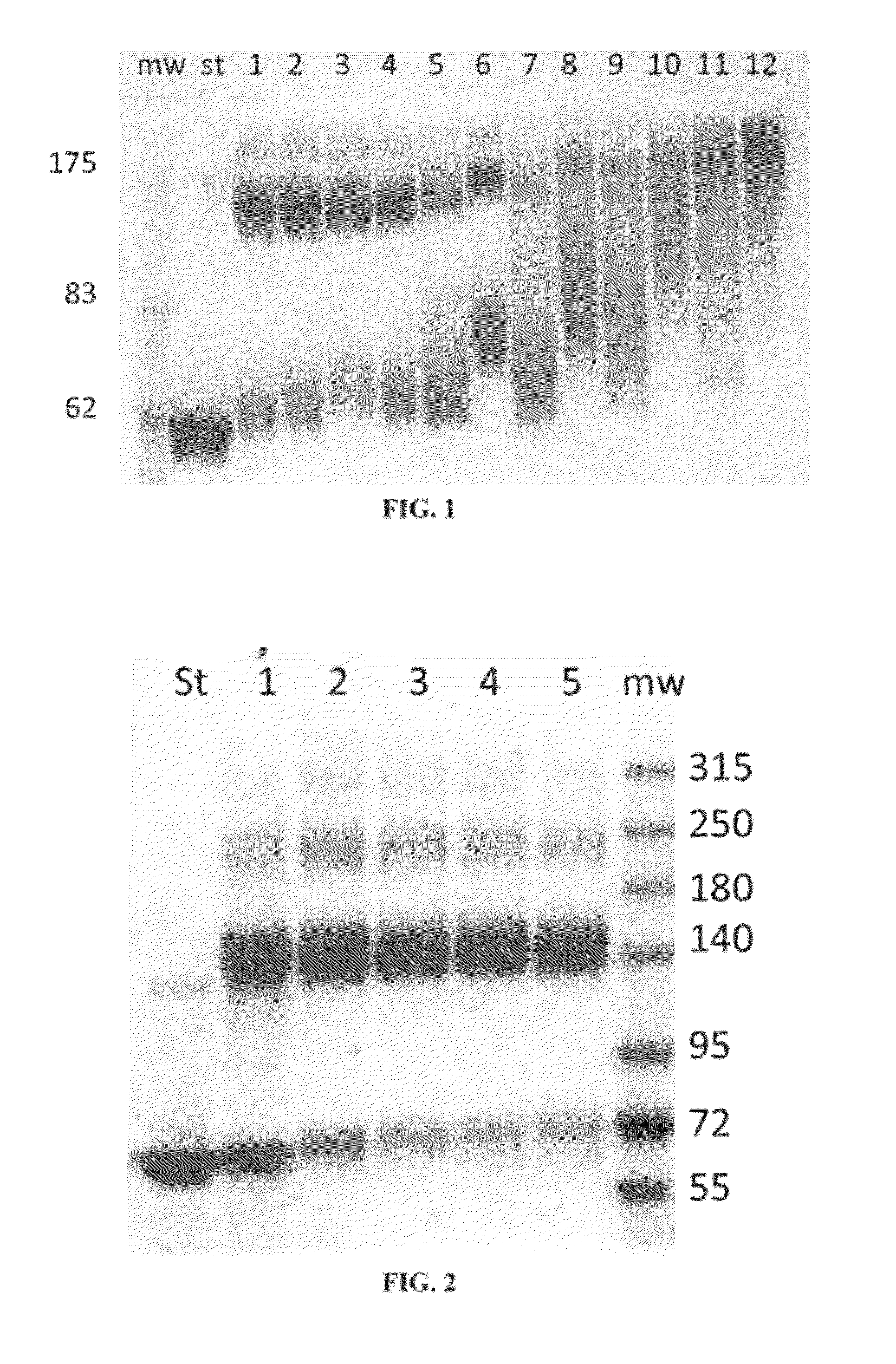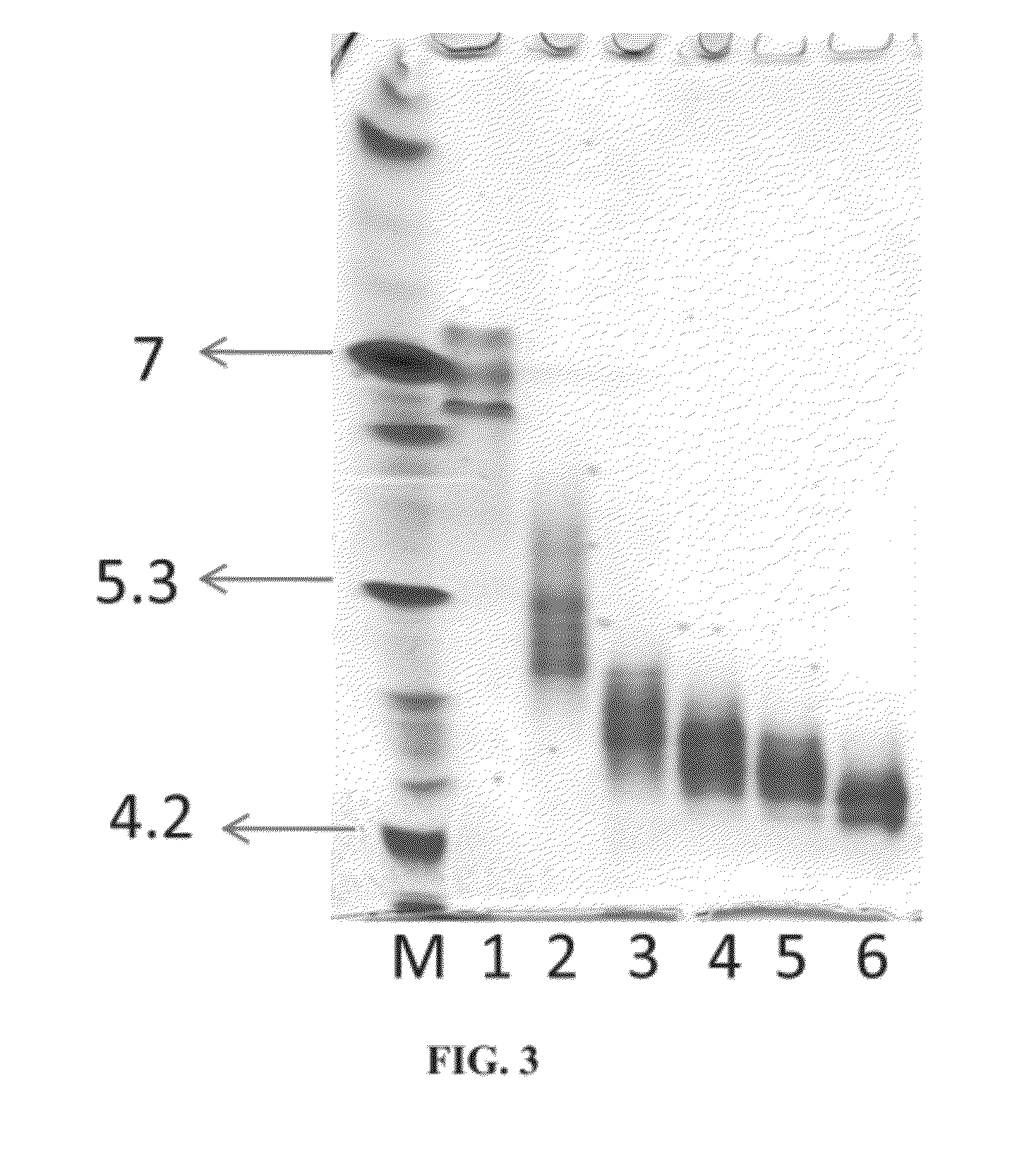Glucocerebrosidase multimers and uses thereof
a technology of glucocerebrosidase and multimeric proteins, which is applied in the field of multimeric protein structures of glucocerebrosidase, can solve the problems of inability to break down glccer, and achieve the effect of improving and lasting activity and enhancing the activity of the protein
- Summary
- Abstract
- Description
- Claims
- Application Information
AI Technical Summary
Benefits of technology
Problems solved by technology
Method used
Image
Examples
example 1
Cross-Linking of Glucocerebrosidase (GCD) with bis-N-hydroxysuccinimide-poly(ethylene glycol) (bis-NHS-PEG)
[0352]Plant recombinant human GCD (prh-GCD) was cross-linked with bis-N-hydroxysuccinimide-poly(ethylene glycol) (bis-NHS-PEG) at 50:1 and 100:1 molar ratios of bis-NHS-PEG to GCD. In order to investigate the effect of cross-linker length on the cross-linking reaction, bis-NHS-PEG with various lengths of poly(ethylene glycol) (PEG) chains were used: bis-NHS-PEG5, bis-NHS-PEG8, bis-NHS-PEG21 (bis-NHS-PEG with a 1 KDa PEG chain), bis-NHS-PEG45 (bis-NHS-PEG with a 2 KDa PEG chain), bis-NHS-PEG68 (bis-NHS-PEG with 3 KDa PEG), and bis-NHS-PEG136 (bis-NHS-PEG with 6 KDa PEG).
[0353]Fresh stock solutions of bis-NHS-PEG in DMSO were prepared at the following concentrations: bis-NHS-PEG5 4.4 mg / ml; bis-NHS-PEG8 5.8 mg / ml; bis-NHS-PEG21 10.2 mg / ml; bis-NHS-PEG45 16 mg / ml; bis-NHS-PEG68 25.8 mg / ml; bis-NHS-PEG136 56.5 mg / ml.
[0354]For cross-linking with a 50:1 molar excess of reagent, 10 μL...
example 2
Effect of Cross-Linking on Stability of Glucocerebrosidase (GCD) in Solution
[0371]The activity of cross-linked plant recombinant human GCD (prh-GCD) was determined in plasma and in simulated lysosomal conditions, in order to assess the stability of the cross-linked prh-GCD under these conditions. For comparison, the activities of non-modified prh-GCD and of non-cross-linked PEGylated prh-GCD were also determined.
[0372]Cross-linked prh-GCD was prepared by reacting prh-GCD with bis-NHS-PEG5 at a 1:25, 1:75 or 1:200 molar ratio, as described in Example 1.
[0373]Non-cross-linked PEGylated prh-GCD was prepared by reacting prh-GCD with by methoxy-capped PEG8-NHS (MeO-PEG8-NHS) at a 50:1 molar ratio. 3.98 mg of MeO-PEG8-NHS in 45 μl DMSO was added from a freshly prepared DMSO stock solution to 9 mL of phosphate buffer (100 mM, pH 8) containing 10 mg of prh-GCD and 100 mg / ml sucrose. The reaction mixture was gently agitated for 2 hours at room temperature and then dialyzed against an appropr...
example 3
Effect of Cross-Linking on Uptake and Stability of Glucocerebrosidase (GCD) in Macrophages In Vitro
[0377]The cellular uptake of cross-linked GCD was determined using rat alveolar macrophages.
[0378]Crosslinked prh-GCD was prepared by reacting prh-GCD with bis-NHS-PEG5 at a 50:1 bis-NHS-PEG5:GCD molar ratio, as described in Example 1.
[0379]Rat alveolar macrophages were placed in wells of 96-well plates at a concentration of 0.5-1×106 cells in 200 μL medium per well (6 wells for each treatment group). 25 μL of a 300 μg / mL solution of prh-GCD or cross-linked prh-GCD was added to each well, along with 25 μL of water or a 10 mg / ml solution of mannan (an inhibitor of uptake via the mannose receptor). The samples were then incubated for two hours at 37° C. in an atmosphere with 5% CO2.
[0380]After incubation, the cells were washed twice in PBS (phosphate buffered solution) with 1 mg / mL mannan, and then twice with PBS, in order to remove remaining GCD. The cells were harvested and lysed with ...
PUM
| Property | Measurement | Unit |
|---|---|---|
| structure | aaaaa | aaaaa |
| multimeric protein structure | aaaaa | aaaaa |
| covalent | aaaaa | aaaaa |
Abstract
Description
Claims
Application Information
 Login to View More
Login to View More - R&D
- Intellectual Property
- Life Sciences
- Materials
- Tech Scout
- Unparalleled Data Quality
- Higher Quality Content
- 60% Fewer Hallucinations
Browse by: Latest US Patents, China's latest patents, Technical Efficacy Thesaurus, Application Domain, Technology Topic, Popular Technical Reports.
© 2025 PatSnap. All rights reserved.Legal|Privacy policy|Modern Slavery Act Transparency Statement|Sitemap|About US| Contact US: help@patsnap.com



